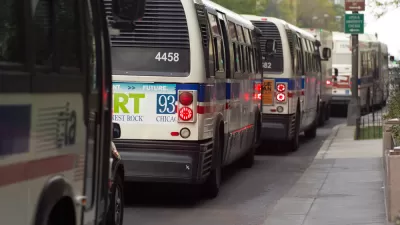With many of California’s low-income workers dependent on public transit to get to work and run daily errands, the San Francisco Chronicle Editorial Board calls on the state’s governor to support faltering transit systems.

Will California Governor Gavin Newsom let the state’s transit systems fail? The San Francisco Chronicle’s editorial board argues that he shouldn’t. “Without money to keep public transit from going kaput, and with fewer grants available to buy electric vehicles, how will lower-income Californians get to work or the doctor’s office?”
Without state intervention, in the Bay Area alone, “The San Francisco Municipal Transportation Agency estimates that it will have to slash one line per month for 20 months starting this summer if state funds don’t come in. BART, meanwhile, is bracing for a worst-case financial scenario that could result in closing service on weekends, shuttering two of its five lines and nine of its 50 stations, and running trains as infrequently as once per hour.”
Meanwhile, the governor’s proposed budget steadfastly supports transit funding cuts. The editorial board argues that “Many other investments will be for naught if California’s public transit systems enter financial ruin.”
The board points out that transit agencies are working to develop better accountability systems as they seek additional funding. “On Thursday, the California Transit Association released a proposed accountability framework that would require agencies receiving state funds to submit detailed plans to recover ridership and address operating deficits. Agencies would also have to submit progress reports every two years outlining how they spent the money.”
FULL STORY: Gavin Newsom can’t just let California public transit collapse

Alabama: Trump Terminates Settlements for Black Communities Harmed By Raw Sewage
Trump deemed the landmark civil rights agreement “illegal DEI and environmental justice policy.”

Planetizen Federal Action Tracker
A weekly monitor of how Trump’s orders and actions are impacting planners and planning in America.

The 120 Year Old Tiny Home Villages That Sheltered San Francisco’s Earthquake Refugees
More than a century ago, San Francisco mobilized to house thousands of residents displaced by the 1906 earthquake. Could their strategy offer a model for the present?

In Both Crashes and Crime, Public Transportation is Far Safer than Driving
Contrary to popular assumptions, public transportation has far lower crash and crime rates than automobile travel. For safer communities, improve and encourage transit travel.

Report: Zoning Reforms Should Complement Nashville’s Ambitious Transit Plan
Without reform, restrictive zoning codes will limit the impact of the city’s planned transit expansion and could exclude some of the residents who depend on transit the most.

Judge Orders Release of Frozen IRA, IIJA Funding
The decision is a victory for environmental groups who charged that freezing funds for critical infrastructure and disaster response programs caused “real and irreparable harm” to communities.
Urban Design for Planners 1: Software Tools
This six-course series explores essential urban design concepts using open source software and equips planners with the tools they need to participate fully in the urban design process.
Planning for Universal Design
Learn the tools for implementing Universal Design in planning regulations.
Clanton & Associates, Inc.
Jessamine County Fiscal Court
Institute for Housing and Urban Development Studies (IHS)
City of Grandview
Harvard GSD Executive Education
Toledo-Lucas County Plan Commissions
Salt Lake City
NYU Wagner Graduate School of Public Service





























